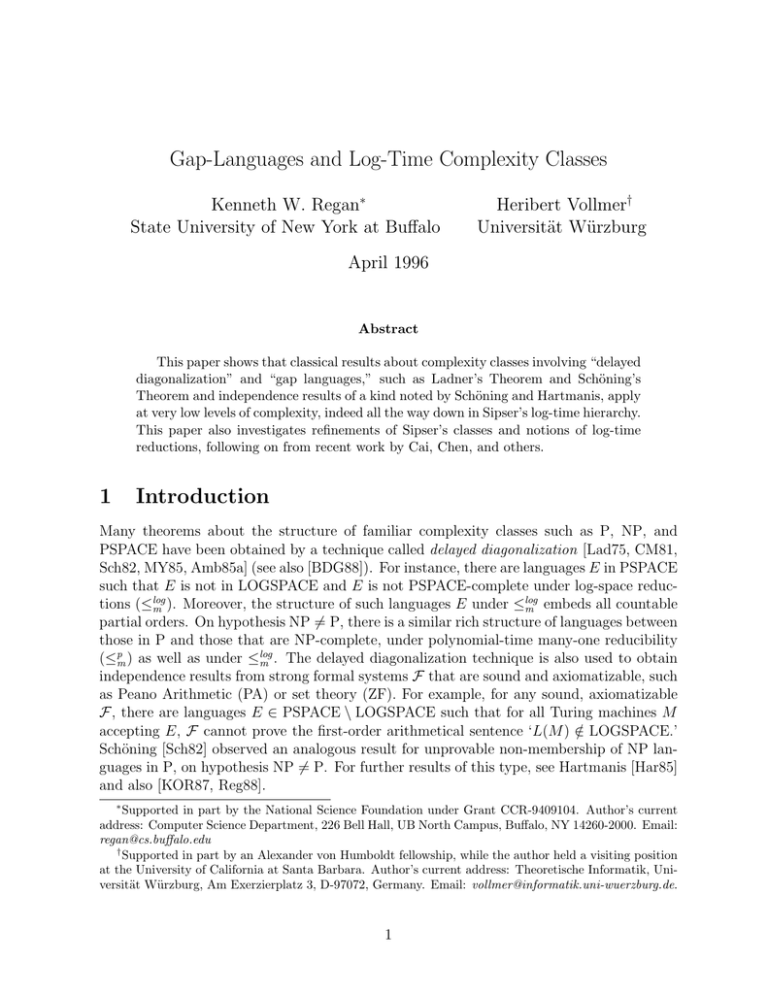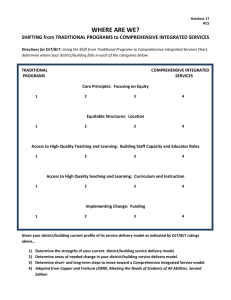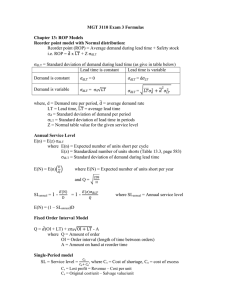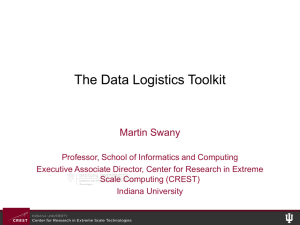Gap-Languages and Log-Time Complexity Classes
advertisement

Gap-Languages and Log-Time Complexity Classes
Kenneth W. Regan∗
State University of New York at Buffalo
Heribert Vollmer†
Universität Würzburg
April 1996
Abstract
This paper shows that classical results about complexity classes involving “delayed
diagonalization” and “gap languages,” such as Ladner’s Theorem and Schöning’s
Theorem and independence results of a kind noted by Schöning and Hartmanis, apply
at very low levels of complexity, indeed all the way down in Sipser’s log-time hierarchy.
This paper also investigates refinements of Sipser’s classes and notions of log-time
reductions, following on from recent work by Cai, Chen, and others.
1
Introduction
Many theorems about the structure of familiar complexity classes such as P, NP, and
PSPACE have been obtained by a technique called delayed diagonalization [Lad75, CM81,
Sch82, MY85, Amb85a] (see also [BDG88]). For instance, there are languages E in PSPACE
such that E is not in LOGSPACE and E is not PSPACE-complete under log-space reduclog
tions (≤log
m ). Moreover, the structure of such languages E under ≤m embeds all countable
partial orders. On hypothesis NP 6= P, there is a similar rich structure of languages between
those in P and those that are NP-complete, under polynomial-time many-one reducibility
(≤pm ) as well as under ≤log
m . The delayed diagonalization technique is also used to obtain
independence results from strong formal systems F that are sound and axiomatizable, such
as Peano Arithmetic (PA) or set theory (ZF). For example, for any sound, axiomatizable
F, there are languages E ∈ PSPACE \ LOGSPACE such that for all Turing machines M
accepting E, F cannot prove the first-order arithmetical sentence ‘L(M ) ∈
/ LOGSPACE.’
Schöning [Sch82] observed an analogous result for unprovable non-membership of NP languages in P, on hypothesis NP 6= P. For further results of this type, see Hartmanis [Har85]
and also [KOR87, Reg88].
∗
Supported in part by the National Science Foundation under Grant CCR-9409104. Author’s current
address: Computer Science Department, 226 Bell Hall, UB North Campus, Buffalo, NY 14260-2000. Email:
regan@cs.buffalo.edu
†
Supported in part by an Alexander von Humboldt fellowship, while the author held a visiting position
at the University of California at Santa Barbara. Author’s current address: Theoretische Informatik, Universität Würzburg, Am Exerzierplatz 3, D-97072, Germany. Email: vollmer@informatik.uni-wuerzburg.de.
1
The languages E constructed above are commonly known as “gap languages.” To
determine which language classes C admit construction of such “gap languages,” Schmidt
[Sch85] formulated a definition of C being recursive gap closed . Schmidt showed that the
class L1 of languages accepted by log-space Turing machines whose input tape is one-way,
which is a proper subclass of LOGSPACE, is recursive gap closed. Regan [Reg88, Reg92a]
generalized the notion of a “gap language” to a function h from Σ∗ to natural numbers, so
as to extend the main theorem of [Sch82] from diagonalization over two to infinitely many
classes, and showed that such functions h can be computed by log-space bounded machines
that run in real time, i.e., where the input head moves right in every step. Vollmer [Vol90]
showed that “gap languages” can be constructed in DLOGTIME. This answered an open
question in [Reg92a] about Immerman’s class FO, which is currently regarded as the best
notion of “uniform” AC0 [Imm87, BIS90], since DLOGTIME is contained in FO [BIS90].
This also implies that any class that is closed under DLOGTIME many-one reductions,
including FO and nonuniform AC0 , is recursive gap closed.
This paper extends the main result in Vollmer [Vol90] from two to infinitely many
classes. We give further applications for diagonalization and independence results in lowlevel complexity classes. We construct languages E ∈ NC1 that are not in the log-time
hierarchy of [CKS81, Sip83], but that are not hard for any level above DLOGTIME either.
Indeed, E does not give any “computational help” to these levels. Moreover, given a formal
system F, E can be constructed so that the assertions “E is in the log-time hierarchy” and
“E is NC1 -complete” are not disprovable by F.
A second contribution of this paper is the study of classes within the log-time hierarchy, together with some notions of “DLOGTIME many-one reductions” that are sharper
than the one standardly defined and used in [CKS81, Bus87, Tor88, BIS90, JMT94]. The
standard one is not transitive and does not preserve membership in individual levels of
the hierarchy. Ours, which extend a suggestion of Cai and Chen [CC95] on how to define log-time languages, remedy these lacks and seem to suffice for most applications of
DLOGTIME reductions and DLOGTIME uniformity in the literature.
2
How to define log time?
To define Turing machines M that operate in logarithmic time, the basic idea is to give
M “random-access” to its input x via a special index tape. The index tape has alphabet
Σ = { 0, 1 } and encodes a natural number as a string using the bijection str defined by
str (0) = λ, str (1) = 0, str (2) = 1, str (3) = 00, str (4) = 01, and so on. We suppose that
the length n of x is initially given on a worktape designated as an “auxiliary input tape” (or
on the index tape itself). When M enters a special query state q? , M receives in response
bit xa of the input x, where a is the number currently on the index tape. The index tape is
not erased by such an operation. Here is where several authorities diverge, as summarized
by Cai and Chen [CC95]:
(U) (for “unrestricted”) M may enter q? at any time, and is charged 1 time unit for the
query.
(S) (for “Sipser”) M is charged dlog ne time units for the query.
2
(R) (for “Ruzzo”) M may enter q? only once in any computation path; without loss of
generality at the end of the path.
Proviso (U) was used in the seminal paper by Chandra, Kozen, and Stockmeyer [CKS81],
and is regarded as “standard” after uses in [Bus87, Tor88, BIS90, JMT94] and others. An
observation credited to [Dow86] in [Bus87] and noted also in [Tor88] is that it is unnecessary
to provide n to the machine: if one allows that queries to a outside the range [0 . . . n − 1]
return a special symbol ‘$’, then M can calculate n in time O(log n) by binary search.
Proviso (S) is equivalent to Sipser’s stipulation in [Sip83, BS90] that all addresses are
encoded by binary strings of length dlog ne, and after each query, the index tape is indeed
erased. Proviso (R) was defined by Ruzzo [Ruz81] for alternating machines.
A fourth proviso, intermediate in power between U and S, has also been defined by
Cai and Chen et al. [CCDF94, CCDF95, CC95], taking an idea from the “Block Transfer”
model of [ACS87]:
(B) (for “block read/write”) M writes two addresses i, j with i ≤ j on its index tape, and
receives the string xi . . . xj on that tape, at a cost of dlog ne + (j − i) time units.
This is equivalent to the “Bc ” formalism in [CC95]. In order for M to run in O(log n)
time, all intervals [i . . . j] addressed must have O(log n) size. The additive dlog ne term,
analogous to proviso (S), ensures that only constant-many such queries can be made along
any one computation path.
B
Still following Cai and Chen, we write ΣUk , ΣSk , ΣR
k , and Σk for the classes of languages
accepted by Σk -alternating Turing machines under the above four provisos, respectively.
e ∈ ΣU }, ∆U for ΣU ∩ ΠU , and similarly for the other provisos. By
We write ΠUk for { L : L
k
k
k
k
definition, ΣU0 = ΠU0 = ∆U0 , etc. We write DLOGTIME for ∆U0 , NLOGTIME for ΣU1 , DLT
B
for ∆B0 , and Σdlt
k for Σk . The first two proper containments in the following are easy to see:
S
∆R
0 ⊂ ∆0 ⊂ DLT ⊂ DLOGTIME.
(1)
For the last, let Lbs be the language of strings x, of length 2d − 1 for some d ≥ 0, in which
the following binary search ends at a ‘1’: Start with the first bit; call it x1 . If x1 = 0 then
go to x2 , else go to x3 . At any bit a, if xa = 0 then go to x2a , else go to x2a+1 . Stop when
2d−1 ≤ a ≤ 2d − 1, and accept iff xa = 1.
Proposition 2.1 Lbs belongs to DLOGTIME but not to DLT.
Proof. Membership in DLOGTIME follows via the algorithm that defines the language.
Now suppose M is a DLT-machine that accepts Lbs in time k log n, for some fixed k ≥ 0.
Consider the operation of M on input x0 = 0n , for sufficiently large n of the form 2d − 1.
M rejects x0 . Call the bit sets { 1 }, { 2, 3 }, { 4, 5, 6, 7 },. . . , { 2d−1 , . . . , 2d − 1 } levels, and
the last, the bottom level . Say that M on input x0 examines a level if it reads at least one
bit in that level.
Then the number of examined levels is at most log(k log n) + 2k, because the first
k log n bits can be regarded as read “for free,” and then since all other levels have size at
least k log n, at most two of those can be examined per block read. Hence the number m
of unexamined levels is Ω(log n). Also note that the DLT machine M reads at most k log n
3
bits in the bottom level on input x0 . Now by changing bits of x0 in the m unexamined
levels, we can create 2m different strings such that the binary searches on those strings end
at 2m distinct bits in the bottom level. Since m > k log n, at least one such string x0 gives
the same computation by M as on x0 . But then changing the target bit of x0 to ‘1’ yields
a member of Lbs that M rejects, giving the desired contradiction.
In fact, this argument shows that a machine accepting Lbs under proviso B must take time
Ω(log2 n).
Cai, Chen, and Håstad [CCH95] show that for all k ≥ 1,
S
B
U
R
ΣR
k ⊂ Σk ⊂ Σk ⊆ Σk ⊂ Σk+1 ,
(2)
S
S
B
thereby refuting Sipser’s claim [Sip83, BS90] that ΣR
k = Σk . (That Σk ⊂ Σk falls out of
their stated proof of ΠSk ⊂ ΠUk ; we suspect that ΣBk ⊂ ΣUk can be shown by combining
their techniques with the binary-search idea above.) Thus the provisos give different classes
at all individual levels of the logarithmic time hierarchy, though the class LOGH =def ∪k ΣUk
is the same under all.
S
Our main motivation for interest in the three classes ∆R
0 , ∆0 , and DLT is that they have
reducibility relations associated to them that remedy some major defects of DLOGTIME
reductions.
Definition 2.1. Given any two languages A and B, we write, respectively, (a) A ≤Um B,
S
R
∗
∗
(b) A ≤dlt
m B, (c) A ≤m B, (d) A ≤m B, if there is a function f : Σ → Σ that many-one
reduces A to B, and a deterministic log-time TM M that computes f in the following
respective manner:
(a) M runs under proviso U, and on any input x and auxiliary input n, j, M outputs bit
j of f (x), together with the length |f (x)| of f (x).
(b) M runs under proviso B, and on any input x and auxiliary input n, i, j, where j − i =
O(log n), M outputs bits i through j of f (x), together with |f (x)|.
(c) M runs under proviso S, and otherwise behaves as in (a).
(d) M runs under proviso R, and otherwise behaves as in (a).
Here (a) is equivalent to the standard definition of f being a DLOGTIME reduction, which
is that the language
Af := { (x, i, b) : bit i of f (x) equals b }
belongs to DLOGTIME, except for the extra clause about M computing the length of
f (x), which is met in all instances that we know. Also noteworthy is that (d) is equivalent to a uniform notion of projection reductions as defined by Valiant [Val82] (see also
[SV85]). A projection reduction is given by a family of mappings πn : { 1, . . . , n0 } →
{ 0, 1, x1 , ¬x1 , . . . , xn , ¬xn }. Intuitively, πn (j) either sets bit j of f (x) to 0 or 1 depending
only on n, or chooses some input bit xi that the output bit depends on, and whether the
output is xi or ¬xi . The uniformity is that in case (d), the mapping πn itself is computed
4
in log-time as a function of n—since the input x is not examined for this, the differences
in proviso do not matter here (also, n0 may depend only on n).
Why study the latter three reducibility relations? Our main motivation is that the first,
which is the standard notion of DLOGTIME reductions, does not preserve membership in
DLOGTIME, nor is it transitive: Define L1 := { x : x begins with log n 1s } and L2 := { x :
x begins with (log n)2 1s }. Then L1 ∈ DLOGTIME (in fact, L1 ∈ DLT), and L2 ≤Um L1 ,
but L2 ∈
/ DLOGTIME, as can be seen by an easy adversary argument. However, the other
reducibilities have nice properties: (For two reducibilities ≤1 and ≤2 , ≤1 ⊂ ≤2 means that
the set { (A, B) : A ≤1 B } is properly contained in { (A, B) : A ≤2 B }.)
S
R
Lemma 2.2 (a) The relations ≤dlt
m , ≤m , and ≤m are transitive, and the equivalence
classes of the language 1Σ∗ under them are, respectively, DLT, ∆S0 , and ∆R
0 .
dlt
S
(b) For all k ≥ 0, the class Σdlt
k is closed downward under ≤m , Σk is closed downward
R
under ≤Sm , and ΣR
k is closed downward under ≤m .
S
U
dlt
U
R
S
dlt
(c) ≤R
m ⊂ ≤m ⊂ ≤m , and ≤m ⊂ ≤m , but both ≤m and ≤m are incomparable with ≤m .
Proof. Parts (a) and (b) are straightforward, while the proper containments in (c) follow
S
from ∆R
0 ⊂ ∆0 and the example with L1 and L2 above. A projection reduction in which
bits 1, 2, 3, 4, 5, . . . of the output depend, respectively, on bits 1, 2, 4, 8, 16, . . . of the input
is not DLT-computable, while a DLT reduction that uses log n input bits is not a Sipser
reduction; we leave the reader to build languages showing the incomparabilities based on
these ideas.
Thus the strong requirement that a machine computing a DLT reduction be able to
output any log-many consecutive bits in log time, which is what makes the reducibility
transitive, also makes it in some sense even “lower” than projection reductions. This
motivates us to define what seems to be the sharpest sensible notion of reducibility, for
studying very low complexity classes.
Definition 2.2. Given languages A and B, write A ≤dlt
proj B if A reduces to B by a Ruzzo
reduction that is also a DLT reduction.
Then the relation ≤dlt
proj is transitive and preserves membership in all levels of all four
hierarchies defined above. Our main results will construct these sharp reductions. We end
this section by noting that the so-called “Sipser functions” Fdn remain complete under these
reductions. Following [Sip83], these are defined for n of the form md (m, d integral) by
Fdn (x1 · · · xn ) = 1 ⇐⇒ (∃i1 < m)(∀i2 < m) . . . (Qid < m)xi1 ·i2 ···id = 1;
(3)
For n not of the form md , one may stipulate that Fdn is identically 0. Then one defines
the function Fd : { 0, 1 }∗ → { 0, 1 } by Fd (x) = F |x| (x1 , . . . , xn ). We identify Fd with the
language { x : Fd (x) = 1 }. For instance, the language F1 equals 0∗ 1(0 + 1)∗ , and belongs
U
to ΣR
1 (hence also to NLOGTIME), but not to Π1 (hence not to DLOGTIME).
Lemma 2.3 (cf. [CC95, CCH95]) For all d ≥ 1,
5
U
(a) Fd belongs to ΣR
d but not to Πd .
dlt
S
(b) Fd is complete for ΣUd under ≤Um , complete for Σdlt
d under ≤m , complete for Σd under
dlt
≤Sm , and complete for ΣR
d under ≤proj .
dlt
S
(c) For all languages A, if A ≤Um Fd then A ∈ ΣUd ; if A ≤dlt
m Fd then A ∈ Σd ; if A ≤m Fd
R
then A ∈ ΣSd ; and if A ≤R
m Fd then A ∈ Σd .
Proof. Part (a) follows from methods and results in [CCH95], improving Sipser’s theorem
S
that Fd ∈ ΣR
d \ Πd [Sip83]. The main point in (b) is that the projection reduction given by
Sipser [Sip83] is also a DLT reduction, basically because any O(log n) consecutive leaves
in a balanced binary tree can be visited in O(log n) moves in the tree. Part (c) for ≤Um is
Theorem 7.4 in [CC95], and the closures for the other reductions follow from Lemma 2.2(b).
Of all our refinements of DLOGTIME reductions, we draw special attention to DLT
reductions. These capture in a natural way the idea of “local replacement” used in many
reductions among NP-complete problems. For instance, a reduction from one graph problem to another may involve constant-size neighborhoods of certain vertices v. The vertex
v is encoded by an O(log n)-bit number, which is why the ability to read O(log n)-many
consecutive bits in a DLT-reduction is appropriate. A second advantage of DLT is that it
avoids a quirk in the relationship of DLOGTIME to linear time on standard deterministic multitape Turing machines, which is denoted by DLIN. DLT is properly contained in
DLIN, but it is unknown whether DLOGTIME is contained in DLIN at all! The proviso
U allows a DLOGTIME-machine M to “jump around” a lot on the input tape by editing
bits toward the middle of its index tape, and we do not see how to simulate this in better
than O(n log n) time on a standard TM.
3
Strong time-constructibility and main lemmas
Definition 3.1. We say a function g: IN → IN is strongly time constructible if there is a
standard (not indexing) Turing machine M such that for all n ∈ IN∗ , M computes g(n)
within O(|n| + |g(n)|) steps, and additionally there is an > 0 such that g(0) > 0, g(1) > 1,
and for all n ≥ 2, g(n) ≥ dn1+ e. The input to g is given in binary notation.
For comparison, the notion of g being “[fully] time constructible” from [HU79] would
require that for all n and all x of length n, M (x) runs for [exactly] g(n) steps. For functions
g, g 0 on IN, say that g 0 majorizes g if for all n, g 0 (n) ≥ g(n). To keep this section selfcontained, we give the following slightly modified form of Lemma 5.2 in [Vol90].
Lemma 3.1 For every recursive function g: IN → IN there is a strongly time constructible
g 0 that majorizes g.
Proof. Define g 00 (n) = max{g(n), n2 }. Then g 00 is recursive, so there is a Turing machine
M computing g 00 . Define M 0 to be a machine that simulates M and additionally, in every
step of its computation prints the symbol ‘1’ on its output tape. Then M 0 computes a
6
function g 0 which certainly majorizes g 00 , and to compute g 0 , M 0 needs exactly as many
steps as there are symbols in the output.
Definition 3.2. A function f defined on strings is strongly growing if there is a strongly
time constructible function g: IN → IN such that for all x, f (x) = 1g(|x|)−1 .
Lemma 3.2 For every recursive function f : Σ∗ → Σ∗ there is a strongly growing function
f 0 that majorizes f .
Proof. Given f : Σ∗ → Σ∗ , define g: IN → IN as g(n) = max|x|=n |f (x)| + 1. Then certainly
fˆ(x) =def 1g(|x|)−1 majorizes f . Now find a strongly time-constructible function g 0 ≥ g as
0
in Lemma 3.1, and define f 0 (x) = 1g (|x|)−1 .
The following main lemma is the “infinite version” of Lemma 5.3 from [Vol90], in the
sense of the diagonalization over infinitely many classes in [Reg92a].
Lemma 3.3 For every strongly time-constructible function g: IN → IN, there is a DLTcomputable function h: Σ∗ → IN with the following property: For all ` ∈ IN there are
infinitely many k ∈ IN such that for all y with k ≤ |y| < g(k), h(y) = `.
Proof. Design a Turing machine M computing h as follows: On input x and n = |x|,
1. M computes 0, g(0), g(g(0)), . . . , until some k is found such that g (k) (0) ≤ n <
g (k+1) (0).
2. M outputs the number of trailing zeroes in the binary representation of k.
To determine the running time of M of Step 1, observe that since g (k) (0) ≤ n and g is
strongly time-constructible, we know that the time needed to compute g (k) (0) is O(log n).
Since g(m) ≥ dm1+ε e we get g (k−1) (0) < n1/(1+ε) , thus the time to compute g (k−1) (0) is less
than c/(1 + ε) · log n for some constant c. Repeating this argument, we see that the whole
time needed to compute 0, g(0), g(g(0)), . . . , g (k) (0) is
k
X
c
· log n = O(log n).
i
i=0 (1 + ε)
Observe, that we don’t have to compute the value g (k+1) (0), but we can simply stop
that computation after c0 log n + 1 steps (for some constant c’), since we then know that
g (k+1) (0) > n. Keeping count of k requires O(log n) steps, since by a well known amortized
cost analysis, to count from 0 to k can be done in time O(k) = O(log n). Thus the overall
time needed for Step 1 is O(log n); and clearly this bound holds also for Step 2. Since for
every number ` there are infinitely many k such that the number of trailing zeroes in the
binary representation of k is equal to `, the conclusion follows.
The preceding lemma can be stated in a form analogous to Theorem 4.1 from [Reg92a],
which is more convenient for the theorems that follow. Here ≤ denotes the standard
lexicographic order on strings.
7
Corollary 3.4 For every strongly growing function f , we can construct a DLT-computable
function h: Σ∗ → IN with the following property: For all ` ∈ IN there are infinitely many
x ∈ Σ∗ such that for all y with x ≤ y ≤ f (x), h(y) = `.
Proof. By hypothesis, there is a strongly time-constructible function g: IN → IN such that
for all x, f (x) = 1g(|x|)−1 . Now apply the construction of the previous proof to g.
4
Applications
Before showing that several well-known structure theorems of the polynomial hierarchy
carry over (unconditionally!) to the log-time hierarchy, we need to take care about how
several basic operations on languages are coded for low-level classes. For one example,
consider the “direct connection language” of a family C = [Cn ] of Boolean circuits, where
the Cn have polynomial size p(n) and gate labels in { 1, . . . , p(n) }, as defined and used in
[BIS90]:
D(C) = { (g, h, t, y) : |y| = n, gate g gets input from gate h in Cn , and gate g has type t }.
Let D0 (C) stand for the same definition with 0m in place of y. The problem with D0 (C)
is that a DLOGTIME machine cannot verify that the final m “padding bits” are all 0;
this is why “y” in the definition of D(C) may be an arbitrary string of length n. (Note
also that D(C) ∈ DLOGTIME ⇐⇒ D(C) ∈ DLT, since the ability to ignore y leaves
only the first O(log n) bits of the input needing to be read. Thus DLT-uniformity is the
same as DLOGTIME-uniformity, another good point for DLT. Furthermore, let D00 (C)
stand for the same definition with m in binary notation in place of y or 0m . Then D(C) ∈
DLOGTIME ⇐⇒ D00 (C) ∈ DLIN. These same remarks apply if the definitions are
strengthened by changing the tuple to (g, h, i, t, ·) and requiring also that g be the ith
input to h under the label ordering, as done in [BI94] to come into line with the original
definitions in [Ruz81].)
A second caveat about encodings concerns the treatment of tuples such as (g, h, t, y)
here. If the first k − 1 elements of a k-tuple (x1 , . . . , xk ) have length O(log |xk |), then we
may encode the tuple as d(x1 )01d(x2 )01 . . . d(xk−1 )01xk , where d(z) doubles each bit of an
argument string z. For general tuples, however, one must beware the danger that the range
of the encoding may not be recognizable by a deterministic log-time TM. This problem does
not arise in the uses that follow.
A third example concerns the join of two languages A and B, which is standardly
defined by A ⊕ B = { 0x : x ∈ A } ∪ { 1x : x ∈ B }. For nearly every reducibility relation ≤r
S
that has been studied, down to ≤dlt
m and ≤m , this join gives the least-upper-bound property
A ≤r C ∧ B ≤r C =⇒ A ⊕ B ≤r C.
(4)
This fails, however, for ≤dlt
proj and other projection reductions, because of the need to examine the extra tag bit of a string in A ⊕ B. We adjust by defining:
A ] B = { xz : x ∈ A, |z| = |x| } ∪ { xz : x ∈ B, |z| = |x| + 1 }.
8
(5)
Then (4) holds for A ] B, because the log-time machine can read the length m of its input
for odd-or-even and select the appropriate map involving the first bm/2c bits accordingly.
dlt
Also, for any language A, A ≡dlt
proj A ] ∅ ≡proj A ] A.
We similarly wish to encode an infinite sequence A1 , A2 , A3 , . . . of languages into one.
For this we need a pairing function h·, ·i that is computable and invertible in TM linear
time in binary notation. We fix the example hx, yi =def x·y·str (2|x| + |y| − 2) from [Reg92b].
We can ignore the fact that the three values hλ, λi, hλ, 0i, and hλ, 1i are undefined; on the
rest of Σ∗ × Σ∗ , h·, ·i is bijectively onto Σ∗ . Then we define:
Aω = { xz : x ∈ Ak , where |z| = h|x|, ki − |x| }.
(6)
Then given the length m of a string w to be examined for membership in Aω , a TM can
compute both n and k such that hn, ki = m in O(log m) time.
The above pairing function is also computable in log time by a two-input-tape variant
of the model developed in Section 2: Let M have two index tapes, one accessing an input
tape holding x and the other an input tape holding y, and let |x| and |y| be initially given
in binary on two worktapes of M . Then M can compute hx, yi in log time under both
the 1-bit R proviso and the proviso for DLT projections, since the “2|x| + |y|” portion has
length logarithmic in |x| + |y|.
Hence we may use this pairing function freely in our final spate of definitions: A
language U is called a universal language for a class C if C is exactly the class of all sets
Uk = { x : hx, ki ∈ U } for k ∈ IN. Observe that by x 7→ hx, ki, we get Uk ≤dlt
m U . We
say that C is recursively presentable (r.p.) if there is a recursive universal language U for
C. In that case, we call [Uk ]∞
k=1 a recursive presentation of C. (Note that Uω is then the
same as U .) A sequence C1 , C2 , . . . of classes is recursively presentable if there is a recursive
language U such that for each k, Uk is universal for Ck . Finally, a class C is closed under
finite variations (cfv.) if for every A ∈ C and every B such that (A ∪ B) \ (A ∩ B) is finite,
we have B ∈ C.
Lemma 4.1 All of the classes defined in Section 2, together with NC1 (which stands for
DLOGTIME-uniform NC1 ) are recursively presentable and cfv. Let ≤r be any of the reducibilities defined in Section 2, let C be any r.p. cfv. class, and let A be any recursive
language. Then the classes
{ L : L ≤r A }
and
{ L ∈ C : A ≤r L }
are r.p. and cfv., unless the latter is empty. The union and intersection of two r.p. cfv.
classes is also r.p. cfv., unless the latter is empty.
Proof. All of these facts are standard (see e.g. [Sch82]); we give details for the case of
{ L ∈ C : A ≤r L }. Let [Tj ] be a recursive presentation of machines that compute
the reducibility ≤r in question, let [Uk ] be a recursive presentation of C, and fix some
L0 ∈ C such that L0 ≤r A. For all j and k, let Mjk be a machine that operates as
follows on any input x: Mjk first spends n = |x| steps checking whether the condition
“y ∈ Uk ⇐⇒ Tj (y) ∈ A” holds for y = λ, 0, 1, . . .. If the condition is found to fail for some
y within those n steps, then Mjk accepts x iff x ∈ L0 . If it holds for those n steps, then
9
Mjk accepts x iff x ∈ Uk . Thus for all j and k, either Uk ≤r A via Tj and L(Mjk ) = Uk ,
or Tj does not reduce Uk to A, in which case L(Mjk ) is a finite variation of L0 . Thus
L(Mjk ) ≤r A, since all of the reducibilities ≤r in question allow “patching” on strings of
finitely many lengths. Since C is cfv., also L(Mjk ) ∈ C. Thus the recursive presentation
[L(Mjk )] captures exactly those languages in C that reduce to A under ≤r .
We first state a log-time version of the “uniform diagonalization theorem” of Schöning
[Sch82] (see also [BDG88, Reg88]), and then state and prove an extension to infinitely
many classes along the lines of Theorem 5.2(a) in [Reg92a]. The main point is that now
the reduction is a DLT projection reduction.
Theorem 4.2 Let C1 , C2 be recursively presentable cfv. classes, and let A1 , A2 be recursive
languages such that A1 ∈
/ C1 and A2 ∈
/ C2 . Then we can construct a recursive language E
such that E ∈
/ C1 ∪ C2 , and yet E ≤dlt
proj A1 ] A2 .
∞
Theorem 4.3 Let [Ak ]∞
k=1 and [Ck ]k=1 be recursive presentations of languages and classes,
respectively, such that for all k, Ck is cfv. and Ak 6∈ Ck . Then we can construct E such that
S
dlt
E∈
/ ∞
k=1 Ck and E ≤proj Aω .
Proof. Let U be the recursive language such that for all k, Ck = { Uk` : k, ` ∈ IN }, where
Uk` technically stands for (Uk )` . Define the function
f (x) = max min{ y : y ∈ Ak 4 Uk` }.
k,`≤x
Take the function g from Lemma 3.2 that is strongly-growing and majorizes f , and then
take h from Corollary 3.4. Define
E=
∞
[
h−1 (k) ∩ Ak .
k=1
Then E reduces to Aω by the map x 7→ hx, h(x)i, which is a DLT projection reduction.
That E ∈
/ ∪k Ck follows by the same analysis as in Theorem 5.2(a) of [Reg92a]. The proof
of Theorem 4.2 is similar.
Because the log-time hierarchy is proper, as in equations (2) and (1), we obtain analogues of results about the polynomial hierarchy in [Lad75, Sch82], but without any unproven hypotheses about non-collapse of the latter. Part (a) is an unconditional “Ladner’s
theorem.”
Corollary 4.4 (a) There exist languages E ∈ NLOGTIME \ DLOGTIME that are not
complete for NLOGTIME under DLT reductions.
(b) There exist languages E ∈ NC1 \ LOGH that are not hard for any level of the
log-time hierarchy above DLOGTIME.
Proof. Recall the Sipser languages Fd defined in (3) following Definition 2.2.
(a) In Theorem 4.2, take C1 = DLOGTIME, A1 = F1 , C2 = { L ∈ NLOGTIME :
U
L ≤m F1 }, A2 = ∅. These choices satisfy the hypotheses. The conclusion in fact gives an
10
E ∈ ΣR
1 that is neither in DLOGTIME nor complete under DLOGTIME reductions, with
dlt
E ≤proj F1 .
(b) First we note that the language Fω defined from the sequence of Sipser languages
belongs to NC1 . This is because strings in Fd have length md for some integral m, and
so the unbounded fan-in expression defining Fd for a given m translates into a Boolean
formula (fan-in 2) of size O(md ). Now take
C1 := LOGH,
C2 := { L ∈ NC1 : F1 ≤Um L },
A1 := Fω ,
A2 := ∅,
and the conclusion follows.
In (a), suppose we now re-define C1 to be the class of languages L ∈ NLOGTIME such
that E ≤Um L, and re-define A2 to be E. Then one obtains E 0 such that E 0 ≤dlt
proj E but
0
U
0
,
indeed
E
≤
6
.
In
like
manner
it
follows
that
for
each
of
the
reducibilities
E 6≤dlt
E
E
proj
m
≤r in Section 2, the degrees of ≤r (i.e., the equivalence classes under A ≡r B =def A ≤r
dlt
B ∧ B ≤r A) are dense. Given A <dlt
proj E <proj B, we can create a “diamond” by
dlt
constructing D such that A <dlt
proj D <proj B, but D is incomparable with E (even under
≤Um reductions if B 6≤Um E 6≤Um A). This is done by taking C1 = { L : A ] L ≤Um E }, A1 = B,
C2 = { L ∈ NLOGTIME : E ≤Um A ] L }, and A2 = A, getting E 00 from Theorem 4.2, and
defining D = A ] E 00 . Here is where the least-upper-bound property (4) begins to be used.
Even more strongly:
Corollary 4.5 One can embed every countable partial order P into the structure of languages E ∈ NLOGTIME \ DLOGTIME so that: every related pair in P maps to two
languages related by a DLT projection reduction, while every unrelated pair maps to two
languages that are not related even by a DLOGTIME reduction.
Proof. One can follow Mehlhorn’s published proof [Meh76] of the corresponding result for
polynomial-time degrees, or that in [Reg83] for embedding posets into p-isomorphism types
of NP-complete sets. See also [MY85, Amb85b, Reg86, Amb88]; the thesis [Reg86] has full
details for embedding upper semi-lattices under one fine reducibility ≤r and preserving
incomparabilities under a coarser reducibility ≤r0 .
2 bits
Cai, Chen, and Håstad [CCH95] define refinements Σ1k bit = ΣR
, Σ3k bits , . . . of ΣSk , and
m , Σk
show that for all k ≥ 0, the containments in these classes are proper.
Corollary 4.6 There exist languages A, E ∈ ∆20 bits \ ∆R
0 such that there is no uniform
projection reduction from A to E.
That is, any machine computing a reduction from A to E must examine at least two bits
of its input x—which is the same as the power to solve x ∈ A without bothering with E
at all. Put another way, E gives no “help” to solving A. We can obtain similar results for
bits
classes Σm
versus Σ`k bits , with k ≥ 0 and m > ` > 0, whose formulation and proof we
k
leave to the reader. (One can also embed all countable partial orders under ≤dlt
proj into the
difference of the two classes, etc.)
11
Another notion of “computational help,” motivated by the well-known Switching
Lemma of [Hås89] for the Sipser languages Fd (variously defined), is the following: Say
f
e
a language E “helps Fd to switch” if Fd ≤dlt
m Fd ] E (where for a set A, A denotes the
complement of A). Our next two results use the infinite case, Theorem 4.3.
Theorem 4.7 There exists a language E ∈ NC1 \ LOGH that does not help any Fd to
switch.
Proof. For each d ≥ 1, define
f
C2d−1 := { L ∈ NC1 : Fd ≤dlt
m Fd ] L },
f ≤dlt F ] L },
C2d := { L ∈ NC1 : F
d
d
m
f,
A2d−1 := F
d
A2d := Fd .
All of these classes are cfv. and are recursively presentable, via Lemma 4.1. For each
k, Ak ∈
/ Ck . Hence the hypotheses of Theorem 4.3 are satisfied. We get E ≤dlt
m Fω , so
f to switch.
E ∈ NC1 , but since E ∈
/ Ck for all k, E does not help any Fd or F
d
Theorem 4.8 In any recursive presentation B1 , B2 , B3 , . . . of NC1 , there must be some d
such that Bd is a finite variation of the Sipser language Fd itself.
Note that this is not the case with recursive presentations of LOGH—one can avoid every
Fd at the dth step by interleaving presentations of ΣU1 , ΣU2 , ΣU3 ,. . . slowly enough. Hence
the inability to avoid this “Fd fixed point” in a recursive presentation of NC1 is surprising.
The governing factor is that the language Fω belongs to NC1 . See section 7 of [Reg92a] for
related results in the polynomial hierarchy and further discussion of fixed-point theorems.
Proof. Suppose not; then with Ad := Fd , Cd := { L : L is a finite variation of Bd }, the
hypotheses of Theorem 4.3 are satisfied. This gives a language E such that E ≤Um Fω , so
E ∈ NC1 , but also E ∈
/ ∪d Cd = NC1 , a contradiction.
Now let F be a sound, recursively axiomatized system of logic that can formalize assertions about Turing machines, such as PA or ZF as mentioned in Section 1. Here “recursively
axiomatized” (r.a.) implies that the predicate PF (d, t) ≡ ‘d is a proof of theorem t in F’ is
decidable, and “sound” means that every theorem t about Turing machines proved by F
is true. To formalize nontrivial properties Π of those languages in NC1 , we refer to a fixed
1
enumeration [Qi ]∞
i=1 of NC -machines. Then the class of languages proved by F to have
property Π is recursively presentable, since presented by:
Ui,d = L(Qi ) if PF (d, ‘L(Qi ) has Π’), otherwise V ,
where V is some fixed language that has property Π.
U
Theorem 4.9 For all k ≥ 1, there are languages E ∈ Σdlt
k \ Σk−1 such that F cannot prove
E∈
/ DLT.
12
Proof. Take A1 := ∅ and C1 to be the class of languages in NC1 that F can prove to
be infinite, which contains the class of languages that F can prove to lie outside DLT, or
outside ΣUk−1 for that matter. Then C1 is recursively presentable, per above remarks. Since
F is sound, A1 ∈
/ C1 . Also take A2 := Fk and C2 := ΣUk−1 . The resulting language E has
the desired properties.
Say that a property Π is “fv-nontrivial” if there is some language A such that all finite
variations of A have property Π, and some A0 such that all finite variations of A0 do not
have Π.
Theorem 4.10 Let C be any class of languages that is closed under ] and under ≤dlt
proj .
Then every fv-nontrivial property Π of languages in C is undecidable. Indeed, for every
sound, r.a. system F, there are languages E ∈ C such that F does not prove the true
statement “E has Π” or “E lacks Π” (whichever applies to E).
The proof is similar to the above. (For a treatment with attention to the most general
details of how statements such as “E has Π” are formalized, see [Reg88].)
5
Concluding Discussion
Schmidt’s definition of a class C being “recursive gap closed” is essentially the same as
saying that for every A1 , A2 ∈ C and recursive function f , there is a strongly-growing
function g majorizing f such that if one defines the “gap language” G to be the set of x
e also belongs to C. Put another
such that k in Lemma 3.3 is odd, then (A1 ∩ G) ∪ (A2 ∩ G)
way, C is closed under the operation of forming the language E in Theorem 4.2. We have
identified DLOGTIME, DLT, and even ∆R
0 as being very small classes that are recursive
gap closed, and the same extends to the higher levels of the log-time hierarchy.
It is possible to go even lower. For any language A, define its associated “fat tally set”
by
F (A) := { y ∈ Σ∗ : str (|y|) ∈ A }.
Now define ∆00 bits to be the class of languages F (A) for A in TM linear time. These are
precisely the languages accepted by deterministic log-time TMs that look at no bits of their
input, but decide everything based on the given length n of the input. This is a proper
subclass of ∆R
0 . Since the function h in Theorem 4.2 does not depend on any bit of the
input, it falls out that ∆00 bits is recursive gap closed.
With appropriate artifice, one can define “loglog-time Turing machines” (cf. the loglogspace TMs in Buss [Bus93]), so that the class of languages F (F (A)) is in loglog time. Then
we claim that the mechanism of Lemmas 3.1 through 3.3 can be tweaked to run in loglog
time on these machines, so that this class is recursive gap closed. With even more artifice,
this can be taken down to a notion of “logloglog time,” and so on.
From all this we can draw an interesting general conclusion: Complexity classes defined
by bounds on running time (or space, or various other complexity measures) really are
qualitatively different from classes in formal language theory. Properties such as “finiteness”
tend to be decidable in moderate-size formal-language classes, for instance the context-free
13
languages, whereas they are undecidable in any class that is recursive gap closed. We have
shown that the “recursion-theoretic structure” that makes all similar properties undecidable
goes all the way down in complexity theory. We look forward to further research on the
combinatorial structure of the very low classes discussed in this paper, especially with
the outward-looking motivations and ideas expressed in Section 2 and the beginning of
Section 4.
Acknowledgments We thank Jianer Chen for sending us draft copies of his papers with
Liming Cai and Johan Håstad, which provided a backbone for our work on the log-time
hierarchy. Eric Allender and David Barrington also gave us some helpful comments.
References
[ACS87]
A. Aggarwal, A. Chandra, and M. Snir. Hierarchical memory with block transfer.
In Proc. 28th Annual IEEE Symposium on Foundations of Computer Science, pages
204–216, 1987.
[Amb85a] K. Ambos-Spies. Sublattices of the polynomial time degrees. Inform. and Control,
65:63–84, 1985.
[Amb85b] K. Ambos-Spies. Three theorems on polynomial degrees of NP sets. In Proc. 26th
Annual IEEE Symposium on Foundations of Computer Science, pages 51–55, 1985.
[Amb88]
K. Ambos-Spies. Polynomial time degrees of NP-sets. In E. Börger, editor, Trends in
Theoretical Computer Science, pages 95–142. Computer Science Press, 1988.
[BDG88]
J. Balcázar, J. Dı́az, and J. Gabarró. Structural Complexity I. Springer Verlag, 1988.
[BI94]
D. Mix Barrington and N. Immerman. Time, hardware, and uniformity. In Proc. 9th
Annual IEEE Conference on Structure in Complexity Theory, pages 176–185, 1994.
Final version to appear in L. Hemaspaandra and A. Selman, eds., Complexity Theory
Retrospective II , Springer Verlag, 1996.
[BIS90]
D. Mix Barrington, N. Immerman, and H. Straubing. On uniformity within NC1 . J.
Comp. Sys. Sci., 41:274–306, 1990.
[BS90]
R. Boppana and M. Sipser. The complexity of finite functions. In J. Van Leeuwen,
editor, Handbook of Theoretical Computer Science, volume A, pages 757–804. Elsevier
and MIT Press, 1990.
[Bus87]
S. Buss. The boolean formula value problem is in ALOGTIME. In Proc. 19th Annual
ACM Symposium on the Theory of Computing, pages 123–131, 1987.
[Bus93]
S. Buss. Algorithms for Boolean formula evaluation and for tree contraction. In
P. Clote and J. Krajı́ček, editors, Arithmetic, Proof Theory, and Computational Complexity, pages 96–115. Oxford University Press, 1993.
[CC95]
L. Cai and J. Chen. On input read-modes of alternating Turing machines. Theor.
Comp. Sci., 148:33–55, 1995.
14
[CCDF94] L. Cai, J. Chen, R. Downey, and M. Fellows. On the structure of parametrized problems in NP. In Proc. 11th Annual Symposium on Theoretical Aspects of Computer
Science, volume 775 of Lect. Notes in Comp. Sci., pages 509–520. Springer Verlag,
1994.
[CCDF95] L. Cai, J. Chen, R. Downey, and M. Fellows. On the parameterized complexity of
problems in NP. Inform. and Comp., 123:38–49, 1995.
[CCH95]
L. Cai, J. Chen, and J. Håstad. Circuit bottom fan-in and computational power, 1995.
Accepted to SIAM J. Comput.
[CKS81]
A. Chandra, D. Kozen, and L. Stockmeyer. Alternation. J. Assn. Comp. Mach.,
28:114–133, 1981.
[CM81]
P. Chew and M. Machtey. A note on structure and looking-back applied to the relative
complexity of computable functions. J. Comp. Sys. Sci., 22:53–59, 1981.
[Dow86]
M. Dowd. Notes on log space representation, 1986. Typewritten manuscript.
[Har85]
J. Hartmanis. Independence results about context-free languages and lower bounds.
Inf. Proc. Lett., 20:241–248, 1985.
[Hås89]
J. Håstad. Almost optimal lower bounds for small-depth circuits. In S. Micali, editor,
Randomness and Computation, volume 5 of Advances in Computing Research, pages
143–170. JAI Press, Greenwich, CT, USA, 1989.
[HU79]
J. Hopcroft and J. Ullman. Introduction to Automata Theory, Languages, and Computation. Addison–Wesley, Reading, MA, 1979.
[Imm87]
N. Immerman. Languages which capture complexity classes. SIAM J. Comput.,
16:760–778, 1987.
[JMT94]
B. Jenner, P. McKenzie, and D. Therién. Logspace and logtime leaf languages. In
Proc. 9th Annual IEEE Conference on Structure in Complexity Theory, pages 242–254,
1994.
[KOR87]
S. Kurtz, M. O’Donnell, and J. Royer. How to prove representation-independent
independence results. Inf. Proc. Lett., 24:5–10, 1987.
[Lad75]
R. Ladner. On the structure of polynomial-time reducibility. J. Assn. Comp. Mach.,
22:155–171, 1975.
[Meh76]
K. Mehlhorn. Polynomial and abstract subrecursive classes. J. Comp. Sys. Sci.,
12:147–178, 1976.
[MY85]
S. Mahaney and P. Young. Reductions among polynomial isomorphism types. Theor.
Comp. Sci., 39:207–224, 1985.
[Reg83]
K. Regan. On diagonalization methods and the structure of language classes. In Proceedings, International Conference on Foundations of Computation Theory (FCT’83),
Borgholm, Sweden, August 1983, volume 158 of Lect. Notes in Comp. Sci., pages
368–380. Springer Verlag, 1983.
15
[Reg86]
K. Regan. On the Separation of Complexity Classes, 1986. Dissertation, Oxford
University.
[Reg88]
K. Regan. The topology of provability in complexity theory. J. Comp. Sys. Sci.,
36:384–432, 1988.
[Reg92a]
K. Regan. Diagonalization, uniformity, and fixed-point theorems. Inform. and Comp.,
98:1–40, 1992.
[Reg92b]
K. Regan. Minimum-complexity pairing functions. J. Comp. Sys. Sci., 45:285–295,
1992.
[Ruz81]
W. Ruzzo. On uniform circuit complexity. J. Comp. Sys. Sci., 22:365–383, 1981.
[Sch82]
U. Schöning. A uniform approach to obtain diagonal sets in complexity classes. Theor.
Comp. Sci., 18:95–103, 1982.
[Sch85]
D. Schmidt. The recursion-theoretic structure of complexity classes. Theor. Comp.
Sci., 38:143–156, 1985.
[Sip83]
M. Sipser. Borel sets and circuit complexity. In Proc. 15th Annual ACM Symposium
on the Theory of Computing, pages 61–69, 1983.
[SV85]
S. Skyum and L. Valiant. A complexity theory based on Boolean algebra. J. Assn.
Comp. Mach., 32:484–502, 1985.
[Tor88]
J. Torán. An oracle characterization of the counting hierarchy. In Proc. 3rd Annual
IEEE Conference on Structure in Complexity Theory, pages 213–223, 1988.
[Val82]
L. Valiant. Reducibility by algebraic projections. L’Enseignement mathématique,
28:253–268, 1982.
[Vol90]
H. Vollmer. The gap-language technique revisited. In Proc. 3rd Workshop on Computer
Science Logic, pages 389–399, 1990.
16







